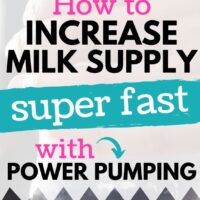This post may contain affiliate links, meaning I may earn a commission for recommending products. Read my disclosure policy for more info.
Does it seem like your milk supply is decreasing? Do you want to stock up your freezer to get a jumpstart for when you return to work?
Power pumping could be the answer you’re looking for.
A mother’s milk supply can decrease for a number of reasons. Hormone changes, foods, your baby’s feeding needs, and even stress can alter how much milk your body will produce.
However, there are plenty of ways to boost your milk supply, and one of those includes a method called power pumping.
Related: 8 Foods to Limit or Avoid While Breastfeeding
Related: 5 Hidden Reasons You’re Gaining Weight While Breastfeeding
What is power pumping?
“Power pumping” is a term that is used to describe when mothers use an electric or manual breast pump to mimic cluster feeding. This process helps stimulate the supply and demand principle of your milk production. By using a cluster pumping method, you will hopefully experience a boost in your supply.
When a baby cluster feeds, they are eating more often but for shorter amounts of time. This behavior tells your body to product more milk. Power pumping imitates this by using a breast pump to stimulate an increase in production.
You may want to power pump breast milk if:
- You notice your supply has been lower than normal
- You want to start stockpiling freezer storage to use later
- You are returning to work
- You are still nursing and have recently become pregnant again
- Your infant isn’t latching properly or has rejected the breast
Related: 7 Best Short Nipple Bottles for Breastfed Babies
How to power pump
Your power pumping schedule will look a bit differently, depending on if you are using an electric or manual model. For obvious reasons, an electric model will take less time than a manual one.
Using an electric breast pump
One of the easiest ways to see an increase in volume will be from using an electric breast pump. By following these recommendations, you should see results in as little as two days.
- Pump for 20 minutes
- Rest for 10 minutes
- Pump for 10 minutes
- Rest for 10 minutes
- Pump for 10 minutes
Although it seems simple enough, it is a time commitment. Each power pump session will take 60 minutes with an electric model.
Using a manual breast pump
Not everyone has access to an electric pump, but that doesn’t mean you can’t power pump. It is still possible to do it with a manual model, but it will take a little more time to complete the process successfully.
- Pump for 12 minutes on each side
- Pump for 8 minutes on each side
- Pump for 8 minutes on each side
You will more than likely need a break (due to a sore hand) from a manual pump. It’s totally fine to take short breaks in between each set to rest your hand.
Tips & tricks
Any time you are nursing or extracting, here are a few essential factors to remember that will help you be more successful:
- Stay hydrated
- Keep snacks handy to maintain your energy
- Stop if it begins to hurt
- Try massaging the breast to encourage letdown
- Take supplements like fenugreek if your doctor says it’s safe to do so
- Eat a diet rich in protein
- Get enough rest
Does power pumping work to increase milk supply?
Moms have raved about the results they’ve achieved when using high energy pumping methods like this. Often, stimulating production either with an infant who is nursing more or by mimicking the behavior by extracting more often than usual will do the trick!
However, keep in mind, your results can vary, depending on your current health and situation. If you keep yourself hydrated and eat enough nutrients, you should expect to see results anywhere from two days up to a week.
If you have the choice of an electric or manual pump, for best results, an electric pump is best. Although they are more expensive, it will take much less time and energy follow through with your power pumping schedule.
How often should I power pump?
One question that’s commonly asked is how often should you be following the schedule and when?
Many moms will want to try to complete their pumping session in the evenings, since this is when babies typically cluster feed. It can be a great starting point, but don’t feel that it’s the only possible time.
Other moms find that they can extract a large amount of milk first thing in the morning. There is no set time of the day that is perfect. Do what works best for you and your own schedule. There’s no need to rush the process and remember to relax!
If you complete an entire pumping session once a day, you may see adequate results in a few days.
While one pumping session per day may be enough for some moms, others may need to perform pumping sessions up to twice per day for a higher milk supply.
Power pumping and breastfeeding
Are you wondering if you can power pump while also breastfeeding? The short answer is yes, you can.
You can initiate this process in a couple of different ways.
- Extract while nursing: Some mothers will pump from one side while they nurse the baby on the other side. This method will only be effective if you continue to feed your baby on both sides, even though you have already pumped on one side.
- Extract after baby is fed: If you don’t want to extract while you’re nursing, you can do it after your baby is fed and full. Since you know there will not be a need for food for at least a little while, this is the perfect time to sneak in your power pumping session.
Both of these methods will help increase the production and give you the results you want.
Commonly asked questions
1. When should I avoid power pumping?
You should not try this at the beginning stages of breastfeeding since your body is still getting used to the baby’s needs. You should also avoid continuing power pumping sessions if you are experiencing pain at all.
2. Are there foods that will help my milk supply?
A well-rounded diet rich in protein and nutrients will help your milk production immensely.
3. What foods should I avoid that can decrease my supply?
Some well-known foods can hinder your production, including parsley, sage, oregano, peppermint, thyme, and caffeine.
4. Is it normal that one breast always has more milk than the other?
Yes, more often than not, mothers will have one side that seems fuller than the other. It is perfectly normal and not a reason for concern unless you are experiencing pain or discomfort. If this is the case, you could be dealing with engorgement.
From increasing your milk production to stockpiling a storage of milk for your little one to consume later, the benefits of using a power pumping schedule are completely worth the extra effort.
It just takes a bit of patience in the beginning!

